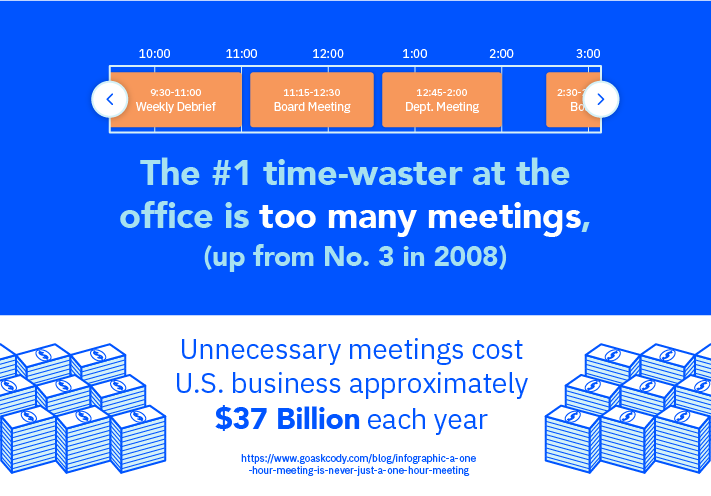Meetings are a fact of life in the business world — and they can certainly be useful.
They serve as a vehicle for communication, give rise to innovative brainstorming sessions, and help businesses develop solutions to critical problems. They can also play a role in maintaining company culture and help employees build solid relationships with their colleagues.
Yet the average worker spends as much as a full workday every week in or planning for meetings.
Is that time well spent?

In today's fast-paced business environment, tracking the value of meetings is essential for organizations to make the most out of their time and resources. Meeting management software has emerged as a powerful tool that not only helps in tracking meeting value but also improves the return on investment (ROI) of meetings.
Tracking meeting value involves evaluating the effectiveness and efficiency of meetings. It allows organizations to identify whether their meetings are productive or mere time-wasters. With meeting management software, organizations can easily track key metrics such as attendance, timeliness, relevance, action items completion, decisions made, and overall participation.
Calculating the true ROI of implementing meeting management software requires tracking the right metrics based on organizational goals. Metrics such as planning time, meeting room features, attendance, time management, relevance, action items completion, decisions made, and overall participation can provide valuable insights into the effectiveness of meetings and the impact of the software.
Tracking these metrics across all meetings allows organizations to determine how effective their meetings are and how meeting management software has improved meeting value over time. By using fact-based metrics and reducing inaccuracies and responder biases, organizations can accurately measure the ROI of meeting management software.
How much do inefficient meetings cost your company?
While a well-planned meeting can be beneficial, over-scheduled or poorly-planned meetings come with a cost — and it is more than just wasted time.
What is the true cost of inefficient or over-scheduled meetings?
Well, if we assume a lower-level employee has an average salary of $45,000, an hour-long meeting costs your business $25. But most meetings, by definition, have multiple people, right?
Let's look at the cost of a 1-hour long meeting with six people:
- Three lower-level employees with a salary of $45,000 = $75
- Two mid-level employees with a salary of $90,000 = $100
- One manager or executive with a salary of $135,000 = $125
Just that one meeting costs your business $300 — and that doesn't include the cost of planning and organizing the meeting, which takes an average of 45 minutes per meeting.
To make it easier, use this meeting-cost calculator from the Harvard Business Journal, which considers factors such as length and number of employees.
In total, unnecessary meetings cost U.S. businesses $37 billion annually.

The hidden cost of meetings — planning time
There are plenty of tips about how to improve the ROI of meetings by creating a succinct agenda or holding stand-up meetings. And those tips can be useful, but there is a hidden cost of meetings that are often overlooked.
In addition to the actual time spent in a meeting, employees also waste a ton of time planning meetings — including finding a room with the right resources, writing an agenda, inviting other employees, and providing directions to the meeting room.
If the meeting includes people outside the organization, meeting planning may also include ensuring the visitor is on a list at reception, sending out parking instructions, and providing Wi-Fi information. This time adds up, and it is just one of the areas where meeting management software can help.
The true value of meeting management software
Studies show that weekly management meetings cost 360 hours of working time each year. In Europe, the estimated cost of unproductive meetings is 32 billion Euros a year.
While meeting management software can't give you those unproductive hours or dollars wasted back — it can help you streamline the meeting planning process and provide the tools you need to reduce back office processes, increase collaboration, and improve the effectiveness of meetings.
An effective meeting management solution provides more than a set of automation tools. It provides a framework of processes that increase collaboration by improving efficiency and consistency of work, even with multiple collaborators.
Here's how meeting management software can improve the value of your meetings:
- Find the most convenient meeting rooms with the right equipment
- Integrate with email clients to send reminders, agendas, and meeting notes automatically
- Attach supporting files or documents
- Send directions to the meeting room
- Provide non-employees with visitor sign-in information and improve the reception experience
- Add catering or associated services to the meeting
- Reduce double-booked meeting rooms
- Export and analyze data and meeting metrics
Now that you understand the actual value meeting management software offers, it's time to consider how to turn those benefits into data you can actually use to improve planning and find opportunities for improvement.
How to calculate meeting management software ROI
When working on getting buy-in for meeting management software, it is beneficial to show how improvements will be tracked. But how do you calculate the true ROI of implementing a meeting management software tool?
The right metrics will depend on your goals. For example, if your goal is to reduce the overall amount of time spent in meetings, then you will want to track time and action items completion. If you want to understand how often meetings veer off-topic, you will want to track relevance.
Let's look at other metrics you might want to consider.
Metrics to track during your meeting
If it is your mission to track data to improve meeting culture and show the ROI of meeting management software, you need to collect information that shows trends and highlights opportunities to improve performance.
Start by creating a spreadsheet, then decide which metrics are most important to your business. Here are a few metrics to consider tracking:
- Planning Time: How long did it take to plan the meeting? Consider time to register off-campus guests as well as send a meeting agenda, schedule the room, etc.
- Meeting Room Features: Did the meeting room have the technology or features required for a successful meeting? For example, smartboard, projector, or video conferencing capability.
- Attendance: How many people showed up versus the number who RSVPed? Did anyone arrive late or leave early? Lack of attendance is a key indicator that meetings are not useful.
- Time: How many minutes late did the meeting start? Why was the meeting late to start, and could anything have prevented this?
- Planned Meeting Time vs. Spent Meeting Time: Did the meeting take as long as predicted? Did certain people or agenda items take longer than anticipated? This information can indicate meetings need to be smaller or break out sessions may be beneficial.
- Relevance: How often did the meeting veer off-topic?
- Action Items Completed: How many action items were closed during the meeting? Were they relevant to the meeting's goal? This indicates the meeting served its purpose.
- Decisions Made: How many decisions were finalized? Were some decisions more important than others? Consider using a point system that counts major decisions as two or three points.
- Overall Participation: Did attendees participate in the discussion? To keep it simple, use a rating system of 1-10 with 1 being "No communication" and 10 being " Full participation from all attendees."
Track these metrics across all meetings to determine how effective your meetings are — and how your meeting management software has improved meeting value over time. If other metrics matter, feel free to add your own. We recommend using fact-based metrics (such as how many people showed up or how many minutes over time the meeting went) to reduce inaccuracies and limit responder biases.
Final thoughts
The metrics above will help track the ROI of meeting management software — and might just show you other areas of opportunity for improving meetings. Meetings are an essential part of business communication and collaboration.
However, inefficient and poorly planned meetings can be costly in terms of time and money. The true value of meetings goes beyond just the dollar cost, as the time spent planning and organizing meetings can also add up. This is where meeting management software comes in.
By streamlining the meeting planning process and providing tools to improve collaboration and effectiveness, meeting management software can significantly enhance the value of meetings.
By tracking metrics such as planning time, attendance, relevance, and action items completed, businesses can measure the ROI of meeting management software and identify areas for improvement.
So, if you want to make the most of your meetings and drive better outcomes, consider implementing meeting management software to optimize your meeting culture and enhance productivity.



